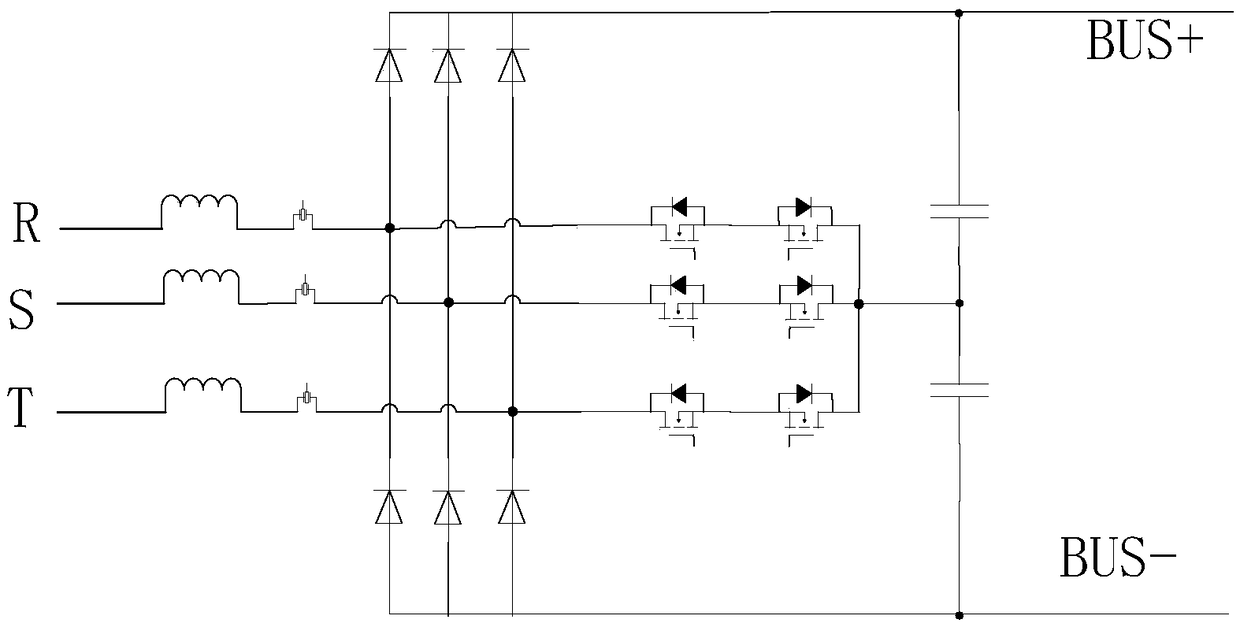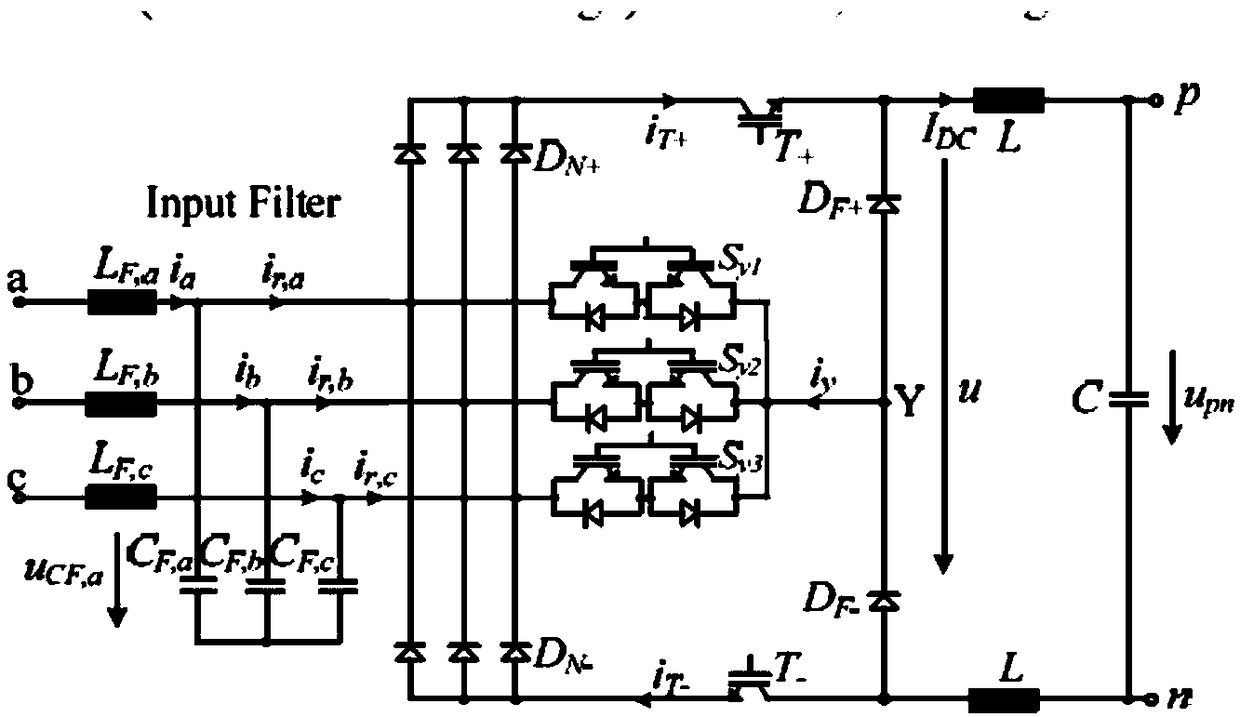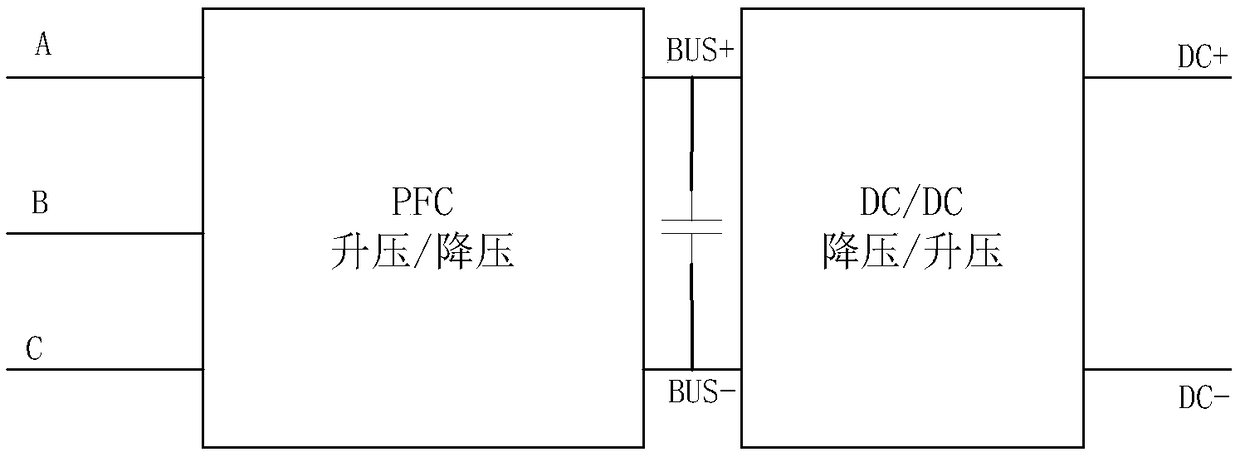A three-phase alternating-current step-up and step-down converter circuit and a control method thereof
A technology of buck-boost conversion and control method, applied in the direction of converting DC power input to DC power output, AC power input converting to DC power output, control/regulation system, etc., can solve the problems of efficiency and limited volume and cost requirements, etc. Achieve the effect of reducing the switch drive potential, high efficiency, and simplifying the control method
- Summary
- Abstract
- Description
- Claims
- Application Information
AI Technical Summary
Problems solved by technology
Method used
Image
Examples
Embodiment 1
[0053] Such as Figure 4 Shown is a three-phase AC-DC buck-boost conversion circuit proposed by the present invention, which includes an input switch tube group, a rectifier switch unit and an energy storage freewheeling unit. The input switch tube group includes three switch tubes Q1~Q3, three switches The tubes Q1~Q3 are respectively set on the three phase lines of the connected three-phase three-wire power supply (or connected through the input filter); the three switching tubes Q1~Q3 are respectively connected to the rectifier switch unit; the sources of the switching tubes Q1~Q3 The three-phase AC input terminals (or input filter terminals) are respectively connected, and the drains of the switching tubes Q1-Q3 are respectively connected to the three input terminals of the rectifying switch unit. The rectifier switch unit is a unit that adds a switch tube at the lower end of the three-phase uncontrolled diode rectifier bridge. The specific connection is that the cathode o...
Embodiment 2
[0060] Such as Figure 4 As shown, a load (or a circuit that can be equivalent to a load) can be connected between the positive output terminal and the negative output terminal. According to the basic principle of circuit step-down, the output voltage should be lower than the input voltage to form a step-down. Therefore, in this circuit, when any two phases of the three phases are turned on, the instantaneous minimum point of a certain interval class should be the 30°, 90°, 150°, 210°, 270°, 330° point of the phase, or Similar to the periodic phase difference relationship point, the lowest value at this time is 1+1 / 2 times the highest amplitude of the phase voltage, and the instantaneous lowest point in a certain interval should be 0°, 60°, 120°, 180° of the phase °, 240°, 300° points, or similar periodic phase difference relationship points, the lowest value at this time is times the maximum amplitude of the phase voltage; for details, please refer to Figure 5 , such as t...
Embodiment 3
[0086] Such as Figure 15 As shown, this embodiment proposes a modified embodiment of the three-phase AC-DC buck-boost conversion circuit according to Embodiment 1, including at least two three-phase AC-DC buck-boost conversion circuits as described above in parallel, and each of the three The switch tube drives between the intersecting DC buck-boost conversion circuits work in an interleaved mode. In order to make the AC input current continuous.
[0087] Through the aforementioned "long" and "short" drive signal control methods, at least two (denoted as N) three-phase AC-DC buck-boost converters connected in parallel can be controlled respectively, and N three-phase AC-DC buck-boost converters connected in parallel The working phase of the converters differs by 1 / N high-frequency cycles; in addition, the positive and negative side inductor current balance control is added to the control algorithm to avoid the current loop crossing in each converter caused by parallel connec...
PUM
 Login to View More
Login to View More Abstract
Description
Claims
Application Information
 Login to View More
Login to View More - R&D
- Intellectual Property
- Life Sciences
- Materials
- Tech Scout
- Unparalleled Data Quality
- Higher Quality Content
- 60% Fewer Hallucinations
Browse by: Latest US Patents, China's latest patents, Technical Efficacy Thesaurus, Application Domain, Technology Topic, Popular Technical Reports.
© 2025 PatSnap. All rights reserved.Legal|Privacy policy|Modern Slavery Act Transparency Statement|Sitemap|About US| Contact US: help@patsnap.com



